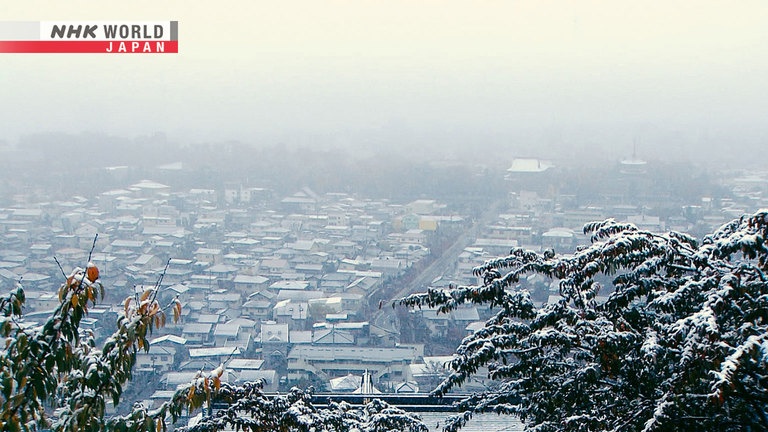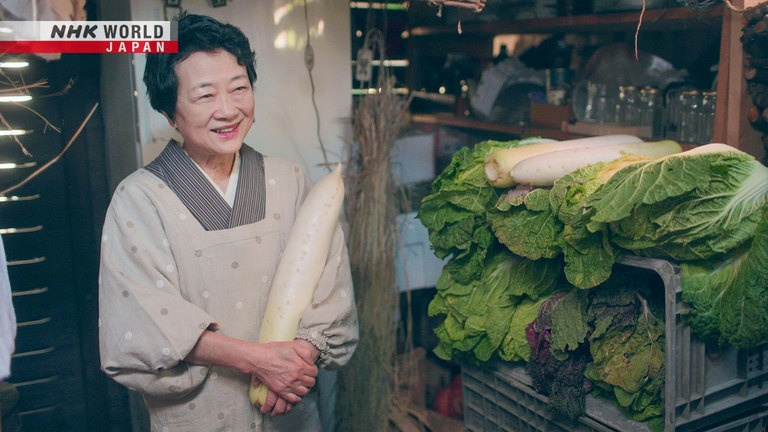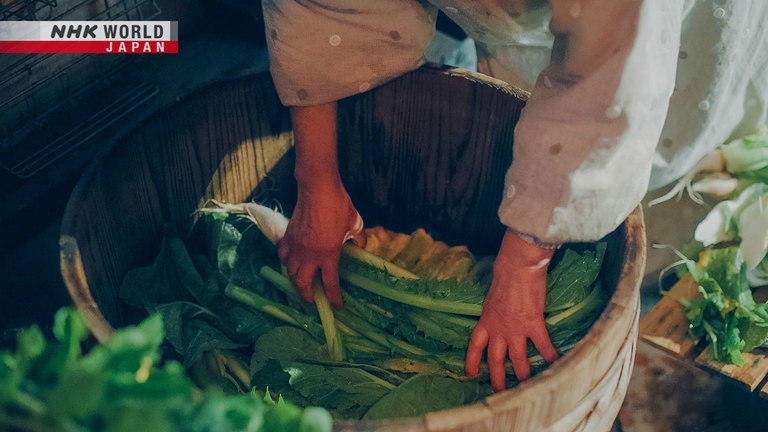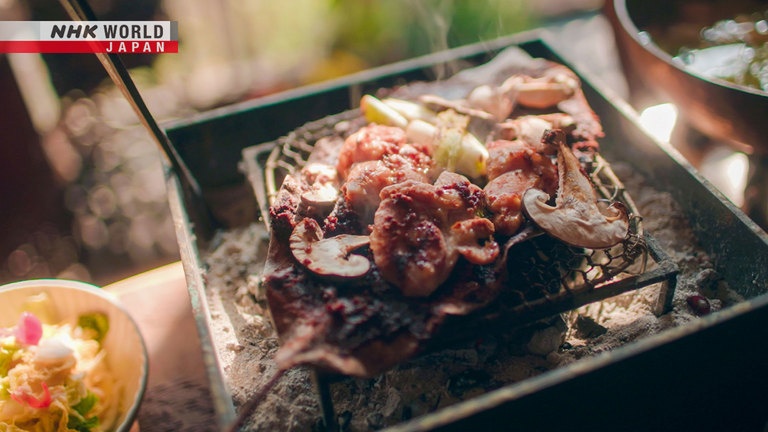Preserving the Seasons
Culinary researcher Yokoyama Takako lives in a mountain region. She cans and ferments local produce to make it through the depths of winter; work supported by nature's bounty and ancestral wisdom.




Transcript
Since ancient times, the Japanese have believed that a life force resides in all creations.
Valuing and caring for the things we use, a "Zero Waste Life."
Pointing the way to better living for a new era.
No food should ever go to waste.
I believe this way of thinking is
where preservation comes from.
Shinshu, now Nagano Prefecture, in central Japan, is surrounded by vast mountain ranges.
In this land enveloped by nature, a woman leads a life that values the wisdom of the past.
Culinary researcher, Yokoyama Takako.
She specializes in the traditional preserved foods of the Shinshu region.
In nearly every corner of her home you'll find containers full of all kinds of preserved foods.
This is apple vinegar.
Cut apples soaked in vinegar,
that's how you make it.
They're at their best when fresh,
but anything left over can be
pickled or preserved as another
way to enjoy them.
The altitude here is quite high.
From summer to autumn there are plenty of fruits and vegetables,
but long harsh winters mean many days where the temperatures are below freezing.
Growing season is only half the year.
So, local wisdom says that whatever
is grown is highly valued and preserved
to be eaten when nothing can be grown.
Autumn ends in late November, and the long winter is nearly here.
A nearby farmer is here to deliver some freshly harvested vegetables.
It's a good crop.
Thank you so much.
A Shinshu specialty: the leafy vegetable known as "nozawana."
The biggest challenge for me is that
she wants these fine roots left intact.
Nozawana is usually harvested by cutting the stalks, but these are pulled out at the root.
She wants to eat the whole plant.
Seeing it that way makes me happy.
I'm grateful for what she's doing,
and I have a lot of respect for her.
In preparation for the coming winter, she gets started right away on preserving the nozawana by pickling them.
In the old days, they washed them
in a clear mountain stream.
The nozawana is laid out in a wooden barrel, and sprinkled with salt.
To help squeeze out excess water, stone weights are placed on top.
Now, all that's left to do is wait.
Even for such a simple task, the wisdom of the past plays a role.
These barrels came from my mother.
They have good breathability,
changing shape with the season,
so they make better tasting pickles.
It's a little bit of ancestral wisdom
that I'm helping to preserve.
Pickles made in this way will remain edible for over six months.
Delicious.
Since childhood, I've always loved them;
something I couldn't live without.
These things from the place I grew up
are always with me, even now.
Now it's time for Yokoyama to make lunch.
She goes out to her home's storehouse.
All sorts of locally-grown produce.
Properly stored, quality won't deteriorate over time.
Daikon radishes can be used for
"oden" stew, simmered, or grated.
And there's...
Shadow Queen purple potatoes,
and some green onions.
About all I need to make it through winter.
The rice straw above serves as insulation.
Her storehouse is basically a big refrigerator, that prevents food from spoiling,
while also keeping it from freezing no matter how cold it gets outside.
She's preparing a traditional local dish, passed down from long ago.
An essential element is this leaf from her garden.
Known as "hoba," its key feature is its resistance to flame.
First "miso," a fermented foodstuff, is spread on the leaf.
Then chicken and vegetables are added, and it's grilled over an open flame for ten minutes.
The aroma of the charred hoba leaf blends with the flavors of the miso and vegetables, with delicious results.
It's a real wintertime dish.
You can keep warm while it cooks.
And miso is an important preserved food.
These local dishes, full of Shinshu food preservation wisdom, are ready to eat.
Called, "hoba miso," this dish serves as the main course.
Miso soup made with locally grown daikon radish and nappa cabbage.
Burdock root, harvested in autumn and preserved, simmered in a soy-sauce base.
Three different kinds of pickles,
nappa cabbage, daikon radish, and of course the nozawana,
each is seasoned differently; a clever way to keep the tastebuds from getting bored over the long winter.
There's a joy in having something
from that moment preserved.
Knowing it's here is a feeling I love.
You also discover a different side,
a new flavor, which is fascinating.
Yokoyama does her best to create simple, easy-to-follow recipes,
with commonly available ingredients and seasonings, suitable for any household.
In recent years she's written books and given talks to spread the word about the beauty of traditional preserved foods.
Her philosophy of love for nature's bounty also finds expression in the kitchen utensils she uses.
Her cutting board was made with scrap wood from locally harvested timber.
Cutting local produce on local timber
provides a sense of comfort.
There's a special joy to cooking.
Pot stands to prevent the table from scorching.
They were made with material from her own garden.
This is my favorite way to enjoy
a fine autumn day.
I love to play in the garden.
For Yokoyama, the soil of Shinshu is life itself.
For as long as she can remember, she's lived her life surrounded by nature's bounty.
My parents sent me out to pick flowers.
When spring came I'd gather mugwort,
and later on, horsetail.
Living like that was natural.
Nature is everything, after all.
Growing up like that shaped the way
I see the world and my sense of self.
Tonight's dinner features a favorite taste from her childhood: a Japanese classic, oden stew.
Daikon radish from her storehouse:
unpeeled, they're used as is.
To hold the fried tofu she uses branches from a tree in her garden.
I learned to make this from my mother.
The flavor came from my parents,
but the toppings are my own touch.
Warming the body and the heart, it's perfect for winter's chill.
Time to eat.
Preserved foods are eco-friendly,
but they're also just plain good.
And by preserving them once again,
passing time and the changing seasons
will make them even more delicious.
This is best, as it also aids fermentation.
That's my biggest recommendation.